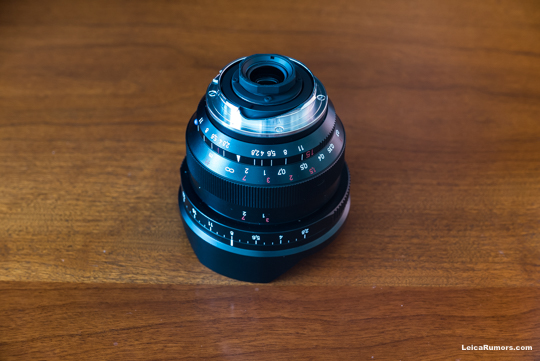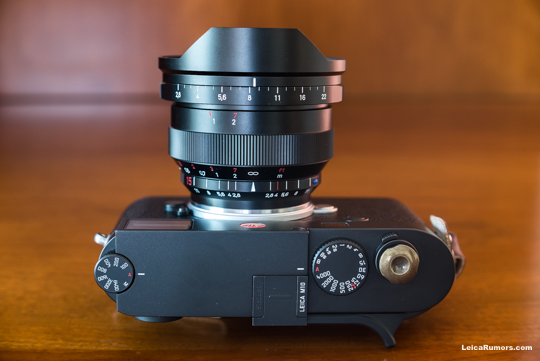General
The widest M rectilinear lens that Leica makes today is the 18mm f/3.8 Super-Elmar ($2,995) if you don’t count the 16-18-21mm f/4 Tri-Elmar-M ($5,195). If you want to go wider, Zeiss and Voigtlander are the only options – Zeiss makes two super wide lenses, while Voigtlander has three:
- Hyper Wide Heliar 10mm f/5.6 VM Aspherical ($1,099)
- Ultra Wide Heliar 12mm f/5.6 VM Aspherical III ($899)
- Super Wide Heliar 15mm f/4.5 VM Aspherical III ($699)
Back in the 70’s Zeiss used to make the Hologon 15mm f/8 lens for Leica M mount (now selling for over $15k).
In this post I will cover the Zeiss Distagon 15mm f/2.8 ZM lens.
The Zeiss Distagon 15mm f/2.8 ZM lens doesn’t have rangefinder coupling:

This should not be a problem because of the “wide” focusing scale – even at f/5.6 you will have pretty much everything in focus (at f/2.8, from 1m to infinity is in focus):

The lens has a detailed focusing scale from 0.3m – 1m followed by 2m and then infinity:

The Zeiss Distagon T* 15mm f/2.8 ZM lens doesn’t come with a viewfinder. I used live view to frame and focus (most of the time zone focusing is enough). Here are the currently available choices for a 15mm viewfinder:
- Zeiss ZI 15mm optical viewfinder (model #1365-662)
- Voigtlander 15mm optical viewfinder (model DA407B)
- Voigtlander 15mm optical viewfinder (model 45DA407A)
With newer digital Leica M cameras you can also use focus peaking (in my case with the M10 I had to press the programmable button for focus peaking, it does not work automatically as it does with Leica lenses). I used focus peaking only when shooting wide open at f/2.8, zone focusing was fine at all other apertures.
Few more notes on the lens: the petal-shaped lens hood cannot be removed. The minimum focusing distance of the lens is 0.3m – probably the shortest of all M lenses. This lens is heavy – it weighs 500 g (17.64 oz). I believe only the Noctilux is heavier. The manual is useless – it is a generic Zeiss ZM lens manual and does not correspond to the actual lens. The aperture is clickable with 10 blades. The aperture ring can be rotated in 1/3 stop increments. The lens is obviously not 6-bit coded.
Astrophotography with Leica M10 and Zeiss Distagon T* 15mm f/2.8 ZM lens
The Zeiss Distagon 15mm f/2.8 ZM lens is a good choice for astrophotography because it allows you to take long exposures without getting any star trails. The maximum recommended shutter speed for a 15mm full frame lens is 33 seconds (source: LonelySpeck):
The Leica M10 (as well as the Leica M Typ 240) has a maximum exposure time of 8 seconds at ISO 6400. As you go down the ISO range, the exposure time increases and can reach 60 seconds at ISO 200:
- ISO 6,400 – 8 seconds
- ISO 3,200 – 16 seconds
- ISO 1,600 – 32 seconds
Leica says that these limits “have been set to prevent uncorrectable imaging errors caused by longer exposure times“. This limitation pretty much eliminates any other ISO level when using the 15mm f/2.8 lens for astrophotography. Almost all pictures of the night sky I took were wide open at f/2.8 with ISO ranging from 1,600-6,400. Even with a 32 seconds exposure, you may still see some “short” star trails. For that setup, I found that a 16 seconds exposure was my best option. I which I could get a few more seconds exposure at ISO 3200 as recommended by LonelySpeck (that’s why my pictures of the Milky Way are generally darker).
Depending on the time of the year, your location and the weather conditions, the Milky Way will appear in the night sky at a different time. While waiting, you can do some test shots to get an idea of the exposure and composition (click on images for larger view):
The Milky Way is starting to show up on the horizon (the orange light is the city of Miami that was 70 miles/110 km away):
You can use some flash lights to create some interesting pictures:
In my case the Milky Way appeared in the sky at around 4 am:
Next is some additional information on the Zeiss Distagon 15mm f/2.8 ZM lens for Leica M mount:
Lens design
The Zeiss Distagon 15mm f/2.8 ZM lens has one aspherical element and a floating element:


MTF charts and distortion data can be found in the brochure).
Technical specs
| Performance | Focal length | 15 mm |
| Aperture range | f/2.8 – f/22 | |
| Camera mount | Leica M-Mount* (ZM) | |
| Format compatibility | Full Frame | |
| Focusing range | 0,30 m (11.81″) – ∞ | |
| Free working distance | ||
| Angular field (diag. | horiz. | vert.) | 110° / 100° / 77° | |
| Diameter of image field | ||
| Coverage at close range (MOD) | 430 x 650 mm (16.93 x 25.59″) | |
| Image ratio at minimum object distance | 1 : 18 | |
| Lens elements | Groups | 11 / 9 | |
| Flange focal distance | ||
| Entrance pupil position (front of image plane) | ||
| Features | Autofocus | – |
| Image Stabilization | – | |
| Physical | Filter thread | M72 x 0.75 |
| Rotation angle of focusing ring | ||
| Diameter max. | ||
| Diameter of focusing ring | ||
| Length (with lens caps) | ||
| Length (without lens caps) | 86 mm (3.39″) | |
| Weight | 500 g (17.64 oz) |
The combined weight of the Leica M10 and Zeiss 15mm ZM lens is 1.24kg / 2.3 lb:

Picture of the lens, filter and packaging:

The lens comes also with a leather pouch (not present in the above picture).
Size comparison
Zeiss Distagon T* 15mm f/2.8 ZM lens vs. Voigtlander Super Wide Heliar 15mm f/4.5 VM Aspherical III lens size comparison:

While most (all?) Zeiss lenses are made in Japan, the Zeiss 15mm ZM lens is made in Germany (left). The 15mm Voigtlander (right) is made in Japan:

Front element – f/2.8 (Zeiss) vs. f/4.5 (Voigtlander):
Lens flare, purple fringing
I didn’t notice any lens flare while shooting against a bright light. Some minor purple fringing is noticeable, but still very well controlled:
Vignetting
Because of the heavy vignetting (at all apertures), the Zeiss Distagon 15mm f/2.8 ZM lens comes with a 72mm center-graduated ND filter (or center density filter). The price of the filter alone is $531! This is how the filter looks like:

Note that this filter will reduce the amount of light that comes trough the lens but it will not change the depth of field.

Here is a quick comparison without the filter (left) and with the filter (right). Like I already said – the vignetting is present at all apertures:
f/2.8


One more – without the center graduated ND filter:

and with the center graduated ND filter:

Even if you decide not to use the filter, the Adobe Lightroom profile for that lens works pretty well:
without LR profile:

The Leica M10 has a lens profile for a Leica 15mm f/2.8 ASPH 11326 R lens, but I did not have a chance to test the results of using this profile.
Sample photos
A few sample photos of the Zeiss Distagon 15mm f/2.8 ZM lens taken with the Leica M10 can be found on flickr (the jpg files are straight from the Leica M10, no correction or post processing)::
Conclusion
Pros:
- Smooth focusing ring
- Clickable aperture ring
- All metal body
- Excellent build quality
- Sharp, contrasty lens that produces nicely saturated images
- Very well corrected lens (in terms of flare and purple fringing)
- Comes with a center-graduated ND filter (you can use also other 72mm filters)
- Minimum focusing distance is 0.3m
Cons:
- Big and heavy lens
- Not rangefinder-coupled (not a big deal)
- Focusing is easy (zone focusing)
- Heavy vignetting at all apertures
- Soft in the corners, but you won’t see it because of the heavy vignetting 🙂
- Expensive ($4,600)

















































